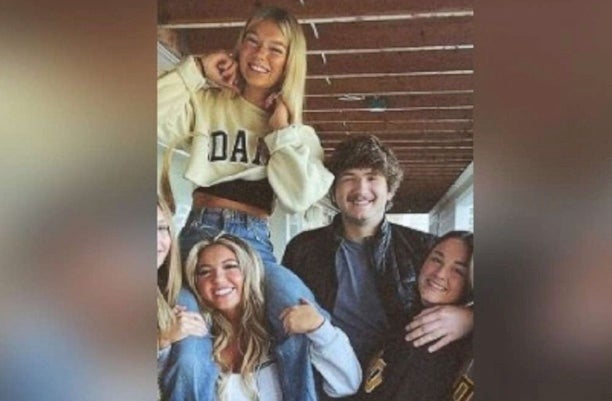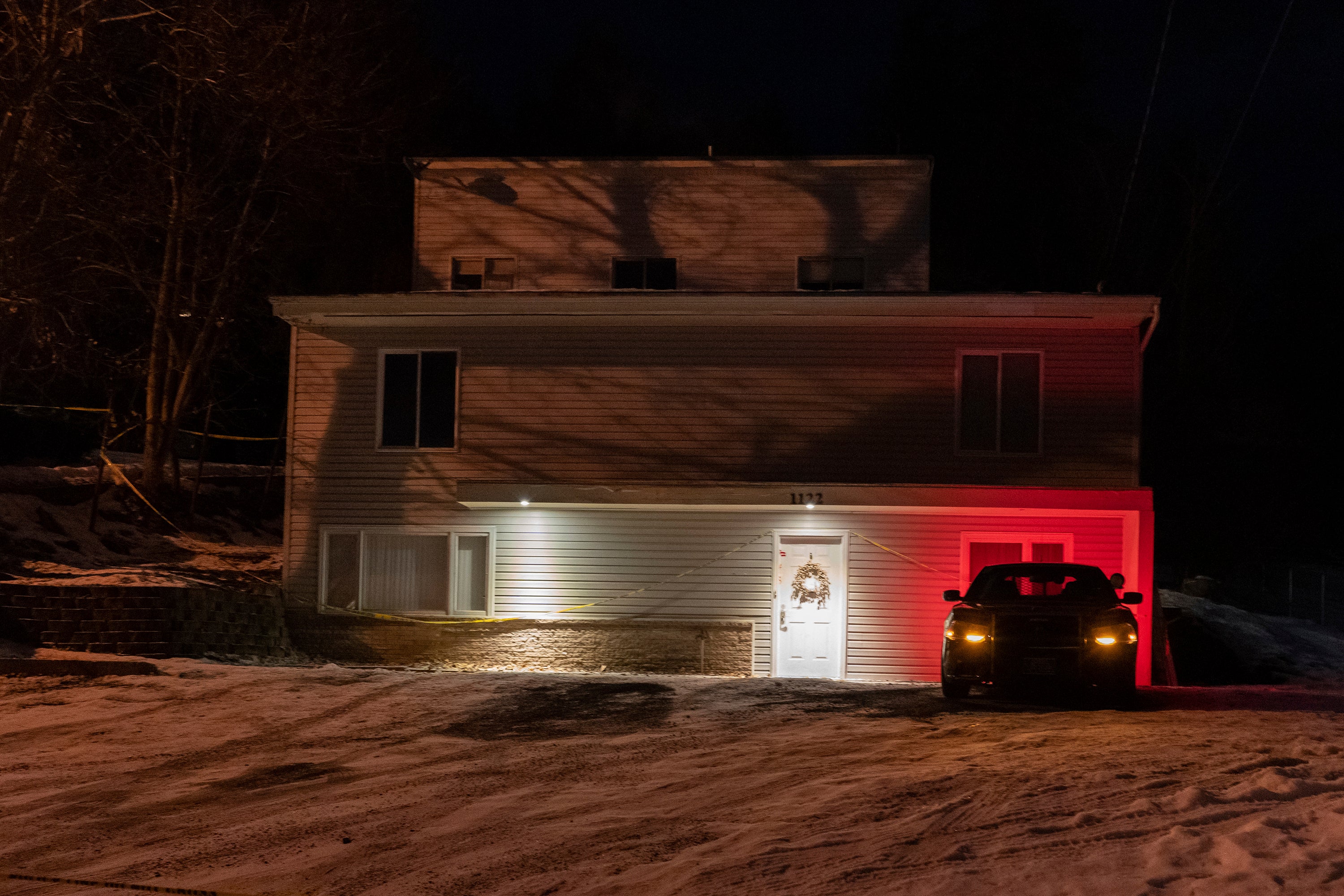She slept through an attack that nearly killed her roommate. Now, she’s defending a stranger in the Idaho murders
There are many chilling similarities between the murders of four Idaho students in November and a 1992 attack at a student home in Buffalo – none more so than the experiences of the roommates who survived. Alanna Zabel tells Rachel Sharp why she feels the need to defend the surviving roommate in Idaho and how she understands the way trauma can shape reactions to such horrifying events


When Alanna Zabel first heard that four young students had been viciously murdered in their rental home after a night out, she didn’t want to think about it.
When she then heard that one of the surviving roommates was coming under attack for how she handled the unimaginable experience, she realised she had to speak out.
“I can understand every aspect of what she went through. Being 19 years old, having fun, you don’t know any reality where a man breaks into your house and attacks your friends,” she tells The Independent.
“I get it, I get it when people say ‘why didn’t she call 911?’ But those people are just used to watching these things happen in movies. This is a very unique and traumatic experience.”
Three decades before University of Idaho students Kaylee Goncalves, Madison Mogen, Xana Kernodle and Ethan Chapin were attacked in an off-campus home in Moscow, Ms Zabel’s college home in Buffalo, New York, was broken into by a man who raped and violently attacked her roommate with a hammer, leaving her for dead.
It was 1992 and Ms Zabel, now 50, was living in a three-storey home with five of her Chi Omega sorority sisters at the University of Buffalo.
One night in September – in the excitement of the fall semester – the roommates had gone to a party at the Sigma Chi fraternity nearby.
The victim was first to head home in the early hours of the morning.
When Ms Zabel arrived home some time later, the door was locked and she couldn’t get hold of her roommate to let her into the house.
In typically comic student fashion, she clambered carefree through the bathroom window.
Once inside, she noticed that it “smelled weird”. She called out to her roommate, but after hearing heavy breathing coming from her bedroom she left her alone – simply assuming that her roommate and roommate’s boyfriend were inside.
“I was drunk and didn’t understand why it smelled weird and I just kind of crashed in my room,” she says.

It was beyond all comprehension that her friend was being brutally attacked at that very moment.
Her friend thankfully survived the attack but only just, with doctors saying she was just minutes from death. She spent months in a coma and her recovery was long.
Four years later, a serial rapist, whose name Ms Zabel does not want to repeat to protect her former housemate, was convicted of rape and attempted murder.
Though years apart, the horrific 1992 attack shares chilling similarities with the slayings of the four students in Idaho today.
When news first broke about the November murders, it “hit close to home” for Ms Zabel.
“It was really hard at first seeing this story pop up. I love true crime and always try to figure out what happened,” she tells The Independent from her home Santa Monica, California.
“But people would send me this story in the beginning and it hit home too much. I didn’t want to open the link and when I did I was like ‘wow’.”
Ms Zabel says that she and her sorority sisters from their 1992 house all messaged each other about the case.
“It brought back a lot. The similarities were chilling,” she says.
In both cases, a three-storey house was known as home to a group of sorority sisters enjoying college life.
The night of the attack was just a typical night out drinking with fellow students (Kernodle and Chapin had also spent their last night at a Sigma Chi party).
Both times, several hours passed between the attacks and the alarm being raised.
And the 911 calls both alerted police to an “unconscious individual” – only for officials to arrive to discover a violent, bloody scene.

But, perhaps the most harrowing similarity is in the experiences of Ms Zabel and Dylan Mortensen – one of the two roommates who survived the Idaho attack.
When the affidavit for suspected Idaho killer Bryan Kohberger was released earlier this month, it revealed for the first time that Ms Mortensen came face to face with a masked man inside the student home moments after her four friends were slaughtered.
At the time of the attack, the 19-year-old was in her bedroom on the second floor – the same floor where Kernodle and Chapin were killed.
She told investigators that she had been woken at around 4am by what sounded like Goncalves playing with her dog on the third floor. A short time later, she heard a woman’s voice saying “there’s someone here” before a man said shortly after “it’s ok, I’m going to help you”.
Opening her door three times to see what was going on, on the last time she saw “a figure clad in black clothing and a mask that covered the person’s mouth and nose walking towards her”.
As she stood in a “frozen shock phase”, the man walked past her and out of the back sliding glass door of the home, the affidavit reveals. The 19-year-old then locked herself in her room, with no 911 call placed for a further eight hours.
Since the release of the affidavit, Ms Mortensen has faced pointed questions as to why she did not call police as soon as she saw an unidentified masked man inside her home. Some online critics have even gone as far as to baselessly accuse the student of being involved in her friends’ murders.
But, much like the 19-year-old student today, Ms Zabel explains she also had a delayed response to the traumatic experience in her student home – as well as a terrifying close call with the attacker.
When she got home that night in September 1992, she went to bed none the wiser as to what had taken place mere feet away from her.
Some time later, she says she heard someone come into her room before they quickly left and she heard the front door close.
At the time, Ms Zabel simply assumed it was one of her roommates. It was only later that she learned that it was the attacker.

The next morning, she discovered her sorority sister in a pool of blood.
Except even then, she explains that she didn’t even realise it was blood.
“I had really unique experience as I found my housemate and I didn’t see the blood,” she says.
“I just saw liquid. My friend was taking her pulse and I thought that she had choked on her own vomit. Right away I said it was vomit.
“Then when the paramedics arrived, they stepped into the room and said the word ‘blood’.
“And in that millisecond the entire room was red.”
Ms Zabel says she has since learned that her mind leaped into a defence mechanism to help her deal with the trauma of what she was seeing and experiencing.
It’s a way of dealing with trauma that she says – decades on – she still can’t fully put into words.
“It’s still a phenomenon to me that, in our experiences as humans, we can see the same light and colour or if I see a dog on the street, you will also see that dog on the street,” she says.
“But then when we are in a state of trauma, the mind will protect us. If we can’t experience something without damage, the mind will block it out.”
She adds: “That blows my mind to this day and humbles me.”
While something still somewhat incomprehensible, her own vivid recollection of how her mind responded to the trauma that day gives her a clear understanding of Ms Mortensen’s reaction to that violent night in November.
“You feel a tsunami of chaos and horror so I can understand why she froze and why you don’t know what to do,” says Ms Zabel.
“You second check yourself. If there’s even a one percent chance that something trauamatic isn’t true then you lean in and believe it’s not true.”
She also knows only too well the guilt that the 19-year-old may feel for not calling 911 earlier as she has spent a long time wondering if things could have been different.
“In my situation, my housemate survived but with a lot of brain damage,” she says.
“I carry the guilt wondering if I had called earlier would she have had as much damage.”
Ms Zabel says that she “didn’t want to rehash” what she went through back in 1992, but she felt a responsibility to speak out in defence of Ms Mortensen – who she sees her younger self in.
“I understand the anguish when you read the affidavit. I also thought ‘oh god, you saw him’. But you have to look beyond that as a human and see that this 19-year-old girl has experienced something atypical, horrific and traumatic,” she says.
“So to accuse her without evidence and diminish her experience and assume she should have done something different when you’ve never experienced anything similar is unacceptable.”
She adds: “It changed all our lives very quickly and it’s something you can’t ever change or take away and it will always be with you. That’s the reason I wanted to stand up for Dylan as she is being chastised online by so many people.”
She urges the critics to stand down, emphasising that without having gone through a similar experience they can’t possibly understand the way trauma can take hold.

“You have to change your perception and perspective and you have to moderate how you speak on this. She will look and live with this for the rest of her life… and just one comment has the ability to crush someone’s spirit,” she says.
Instead of facing a barrage of suspicion and criticism, Ms Zabel says Ms Mortensen and the second surviving roommate Bethany Funke both need support in dealing with the trauma they have endured.
“I am 100 per cent in support of them. They have a long road ahead and I’m sure they will find their way,” she says.
Back in 1992, she says that she and her roommates didn’t get any offers of counselling from their college. But social media also wasn’t around, she adds.
“No one got counseling so I packed it all away in a file and moved on in my life but the file and the pain and the fear was still there,” she says.
As well of the guilt over her reaction to her own experience, she has also struggled to come to terms with the knowledge of just how close she came to the attacker.
“The attacker was standing over my bed as I slept. I didn’t sleep for about a year after that because as soon as l closed my eyes I felt someone chasing me,” she says.
“Every single time I think of it I’m on the verge of tears. It never leaves you.”
She adds: “I wish I had done more work to process it all back then so I hope they get the support and are able to process every aspect and feeling of this experience.”
From one survivor to another, she has a poignant message for the two roommates who lived through the attack: “Make sure you know you’re not responsible in any way, celebrate the lives of your friends and honour them in the way that you live your lives.”



